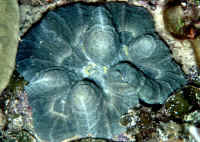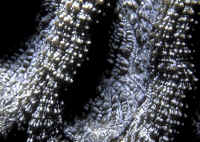|
Related FAQs: Mussids, Mussids
2, Mussid Identification,
Mussid Behavior, Mussid Compatibility, Mussid Selection, Mussid Disease, Mussid Systems, Mussid Feeding, Mussid Reproduction, Stony/True Coral, Coral System Set-Up, Coral System Lighting, Stony Coral Identification, Stony Coral Selection, Coral Placement, Foods/Feeding/Nutrition, Disease/Health, Propagation, Growing Reef Corals, Stony Coral Behavior,
Related Articles: Large Polyp Stony
Corals, Stony or True Corals,
Order Scleractinia, Dyed Corals,
/The Best Livestock For Your Reef Aquarium:
Brain, Meat, Pineapple
Corals, Family Mussidae, Pt. 5
To:
Part 1, Part 2, Part
3, Part 4,
Part 6, Part 7,
Part 8,
|
|
|
By Bob Fenner
|
|
Genus Manicina: (see also
Trachyphylliidae here on WWM; though this is a genus of the Faviidae).
| Manicina areolata, Rose Cactus, to 6 inches. Either
small elliptical encrusting colonies with a central canal, or hemispherical
with winding valleys and a flat bottom. Brown, gray, tan, green in color.
Roatan 2019. |
%20MD.JPG)
|
Bigger PIX:
The images in this table are linked
to large (desktop size) copies. Click on "framed" images
to go to the larger size. |
|
%20MD.JPG)
|
Genus Mussa Oken 1815. Monotypic, only found in the tropical
West Atlantic.
| Mussa angulosa (Pallas 1766), Spiny Flower Coral. Large, fleshy
polyps that are well-separated. When retracted, skeletal
elements/septa appear spiny. To two feet in diameter tightly packed dome
shapes. Occur in greens, blues, reds, browns. Below:
Bahamas images of larger, smaller colonies and a close-up by Di.F in Cozumel. |
 |
 |
 |
Bigger PIX:
The images in this table are linked
to large (desktop size) copies. Click on "framed" images
to go to the larger size. |
%20MD.JPG)
%20MD.JPG)
%20MD.JPG)
%20MD.JPG)
%20MD.JPG) |
To:
Part 1, Part 2, Part
3, Part 4,
Part 6, Part 7,
Part 8,
|
|

